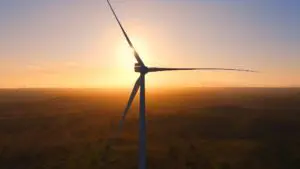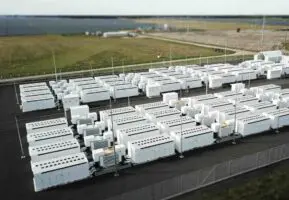Napthine’s coal dreams are blowing in the wind
Victorian Premier Denis Napthine should have seen the future, because he was standing in the middle of it on Friday when he opened the 420MW MacArthur wind farm – the largest in the Southern Hemisphere. The 140-turbine wind farm lies in the middle of his electorate, as do many of the state’s wind farms.
But did it register? Not much. Just days earlier, Napthine disappointed hopes that a change of Premier from the stubbornly anti-wind Ted Baillieu might mean a change of direction for the state that once had the most progressive climate change and clean energy targets in the country.
But then Napthine announced he had dumped the environment department, and merged the department of energy resources into the department of state development, business and innovation in the hope of gaining a “sharper focus on major development opportunities such as Victoria’s coal resources”. It is frightening to think that the government is still entertaining the ridiculous suggestion that the state’s brown coal reserves could, or even should, be exported.
Fossil fuel projects failing investment test
Napthine and others should get out more. Or vary their reading material. In NSW, as Zane Alcorn writes today, the fourth coal loader planned for Newcastle has been put on hold, and it may never be built. In the US, it is a similar story, with one of five coal terminals planned to export U.S. coal to Asia Oregon and Washington shelved in the fa e of fluctuating energy demand and environmental opposition. The three backers (Metro Ports of California; Mitsui & Company, a Japanese trading company subsidiary; and Korean Electric Power Corporation) all pulled out of the deal.
As one energy executive noted this week, the Chinese don’t want to import coal – they don’t even want to move it around their own country – and are bent on limiting its use as much as they can, to address some of the chronic pollution industries in the country. The difference between China and other countries is that they can see the pollution. That’s a powerful motive to act. Now, Woodside has shelved plans for the $45 billion Browse Basin LNG project in WA. It’s good news for James Price Point, and the environmentalists who fought for its protection. But Browse was always considered a marginal project at best, and the spiralling costs have finally caused a major rethink. It’s a repeating theme: Fossil fuel development costs up, renewable energy development costs down.
Economics versus ideology
But if conservative governments refuse to see the future, the investment community is increasingly opening its eyes to its implications. This week, Citi said half of the value of listed coal reserves in Australia could be lost if serious climate action was taken by 2020. It suggested that coal miners might be best advised to dig them up as quickly as possible, lest they leave some market value in the ground. It wasn’t so much of an endorsement of the strategy as an observation of the leading obvious – delay and confusion have been the strategy of the fossil fuel industry for nearly two decades. It’s just that now, it’s getting urgent.
But it may not be just climate action that finishes off the coal industry. It could also be the plunging cost of clean energy. Citi cited this possibility, noting that wind was cheaper than many fossil fuels, and large scale solar will soon follow. This echoes observations by analysts such as Bloomberg New Energy Finance, and the warnings issues in the last few months by Macquarie Group, Deutsche and UBS . Even the credit ratings agencies are now sounding the alarm, with Moody’s suggesting this week that the credit ratings of European fossil fuel generators were vulnerable, echoing sentiments by fellow ratings agency S&P.
The predictable demise of the car manufacturing industry
Headlines from most major newspapers this morning screamed that Australia’s car manufacturing industry is doomed. It shouldn’t be a surprise, because its fate has been sealed ever since the major manufacturers locked themselves into “big car” production lines – as recently as 2007 – just when it was clear that fuel efficient models would win the day. As Ray Wills, the former head of the WA Sustainable Energy Association, points out, in 2007 the Industry Minister Ian Macfarlane was praising the industry’s commitment to an 8-cylinder Pontiac as showing how the Australian automotive manufacturing sector “is being transformed into an outward looking, internationally competitive … industry.” Instead, it was digging its own grave.
Wills says we’ve done the same with housing – with the lack of adequate housing energy efficiency standards locking in Australian families into a spiral of higher electricity bills. Even in 2007, it was clear that mandated energy efficiency measures wre the solution to both problems. That’s why the prime minister commissioned the its national energy efficiency review. Still nothing happens, because one thing that utilities do not want is legislated reduced demand. Their business models simply can’t cope. But others pay the cost.
Macarthur opens, but what’s next?
As mentioned in the first item, Australia’s biggest ever wind farm -the 420MW Macarthur project in south western Victoria – was officially opened today. But if that was cause for celebration, the mood in the renewable energy industry is sombre. Most projects are at a standstill – despite the existence of 20 per cent renewable energy target, most major utilities are stonewalling on signing power purchase agreements, hoping that a Coalition government will quickly move to dilute the target and effectively reduce the number of wind turbines and solar farms to be constructed by around half.
Restrictive planning laws in Victoria, and uncertainty over the fate of planning laws in NSW, is holding back billions of investments. The head of one prominent Australian wind energy developer – who operates in north and south America, Asia and South Africa, said that the domestic market was by far the most frustrating – as it has been since around 2005. Macarthur represents what should be possible in Australia, but is not being delivered. It is not by chance that it is half owned by one of the three big utilities – they have nearly complete control over the industry.
Meanwhile, radio shock jock Alan Jones could barely contain himself this morning, inviting in Ron Boswell for a mutual. According to Jones this morning, wind energy costs more than $200/MWh, and solar energy costs more than $470/MWh. Even the Bureau of Resource Economics will tell you that is nonsense, although BNEF will give some more realistic assessments. The frightening thing is that many in the Conservative parties – be they state or federal – share the same view.








